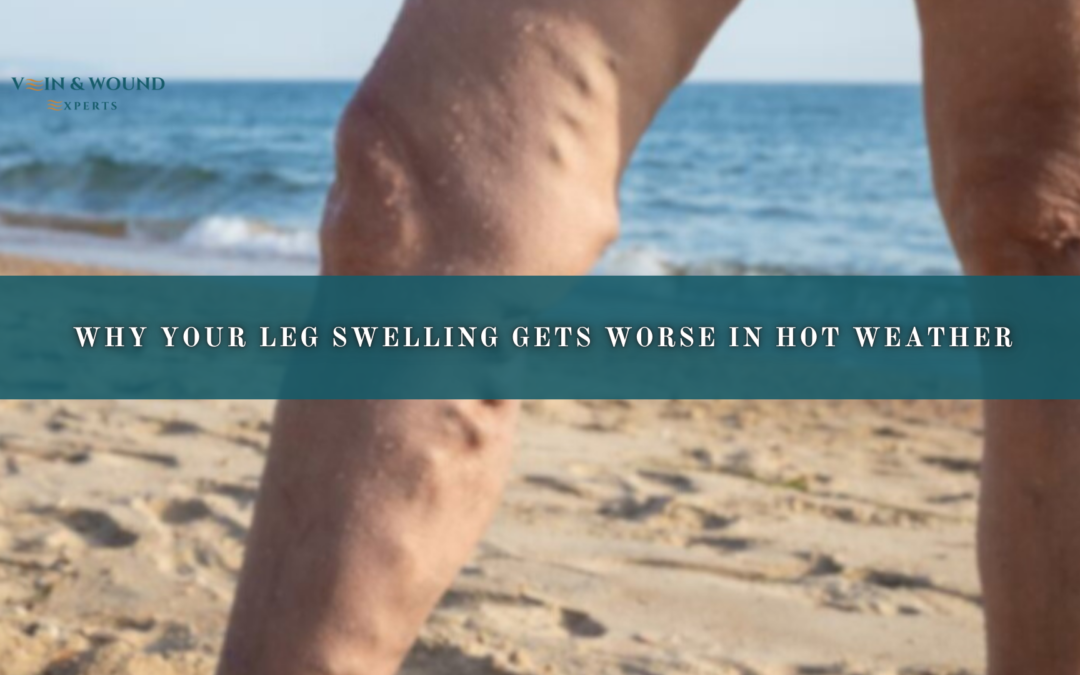Heat and Vein Symptom Flares ☀️
Hot weather affects the body in many subtle ways, but one of the most frustrating effects many people notice is that leg swelling worse in heat becomes more pronounced during the warmer months. Even individuals who normally feel fine throughout the year may suddenly experience puffiness, heaviness, or visible changes in their legs when temperatures rise. This seasonal shift isn’t random, it is rooted in how the circulatory system reacts to external heat, specifically in the flexibility of vein walls and the body’s effort to cool itself.
Why Heat Changes the Way Your Veins Work 🔥
To cool the body, the circulatory system increases blood flow near the skin’s surface. This natural adjustment allows heat to escape, but it also places additional strain on the veins in the legs, especially when the temperature is consistently high. One of the key mechanisms behind this shift is vein dilation, which allows more blood to circulate outward but also reduces the veins’ ability to push blood upward efficiently.
The walls of your veins are elastic, designed to stretch and adapt to pressure changes. However, when exposed to heat, that elasticity increases even further. Instead of assisting circulation, this extra flexibility may cause the veins to widen more than they should, slowing the movement of blood against gravity. As blood pools in the lower limbs, swelling develops, followed by sensations of throbbing, tightness, or heaviness.
Role of Vein Wall Elasticity in Summer 🧬
Healthy vein walls expand and contract smoothly in response to daily activity, but temperature affects this elasticity just as much as movement. During hot weather, the veins in the legs relax more than usual, which can contribute to temporary stagnation within the lower limbs something that becomes more noticeable in people who already have mild circulation problems.
This is why swelling often appears more quickly when someone is standing or walking on warm days, even if their overall health seems stable. Age also influences this response, as vein walls gradually lose firmness over time, making them more sensitive to seasonal temperature shifts. Even a day that feels only moderately warm can lead to a change in leg comfort if the veins are already working harder than they should.
Why Some People Develop More Swelling Than Others
Not everyone experiences the same level of discomfort in hot weather, and for many, even mild or previously unnoticed circulation issues become more noticeable as temperatures rise. When the valves inside the veins are already functioning a little slower or not closing as firmly, heat can intensify the problem and make swelling appear more quickly. People who spend long hours sitting or standing, carry extra body weight, or have a history of leg injuries or surgeries often feel the effects more strongly. Pregnancy and naturally flexible or weaker connective tissue can also make someone more sensitive to warm temperatures. Even those who feel perfectly fine during cooler months may suddenly notice heavier legs or puffiness once summer heat places more pressure on an already weakened venous return.
How Heat Triggers Visible and Physical Changes in the Legs 👣
Swelling is the most obvious change, but heat can bring additional signs that the veins are under extra pressure. These may include:
- A sense of tightness around the ankles
- Soft puffiness that increases throughout the day
- A warming or tingling sensation in the lower legs
- More noticeable surface veins
- Increased fatigue in the calves
These shifts result from the body redirecting blood outward to release heat while the leg veins struggle to push it back toward the heart.
Seasonal Strategies to Ease Swelling 🌬️
Warm weather doesn’t have to lead to discomfort if you know how to support the veins during higher temperatures. Small adjustments make a noticeable difference and help maintain healthy circulation throughout the season.
Helpful approaches include:
- Cooling the legs with cold water or compresses
- Taking short breaks to elevate the legs above heart level
- Moving frequently to activate calf muscles
- Staying well hydrated to maintain blood consistency
- Wearing lighter clothing that doesn’t restrict circulation
These simple measures strengthen the veins’ ability to handle the extra strain brought on by heat.
Practical Daily Habits for Warm-Weather Relief 🧊
Consistency matters when managing temperature-related vein symptoms. Instead of waiting for discomfort to escalate, proactive steps can help the veins stay stable even on the hottest days. People who spend long hours outdoors benefit from mid-day cooling periods, while those who work indoors may find relief by adjusting posture or using brief stretch sessions to reset circulation.
Hydration plays a particularly important role. When the body is dehydrated, blood becomes more concentrated, making it harder for veins to move it efficiently. Drinking enough water supports smoother circulation and reduces the severity of swelling.
Staying Ahead of Seasonal Leg Swelling 🌱
Heat-related leg discomfort is more than just a seasonal annoyance it is the circulatory system responding to environmental stress. Recognizing how temperature affects vein wall elasticity helps individuals understand why symptoms appear and how to manage them effectively. With mindful adjustments, daily routines, and simple cooling strategies, it becomes much easier to keep the legs comfortable throughout warm weather.

Andy Sharifi
Position
